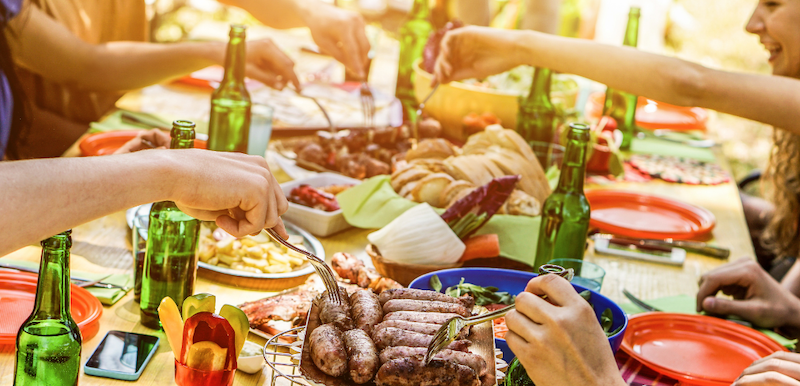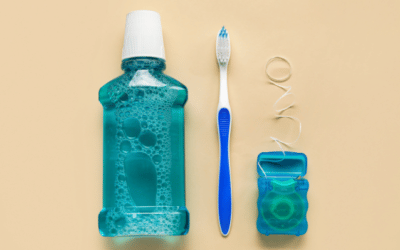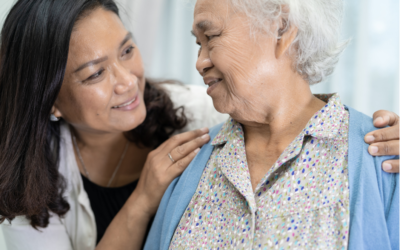The social challenges of eating with a swallowing disorder
As humans, we do a lot of our socializing around food. When making plans, they are often centered around having a meal or a drink together. In the pre-pandemic world especially, food featured heavily in our social lives. As cities are opening again, and in-person socializing starts picking up, we’re starting to see people dining in restaurants more and having others over for meals. There are benefits to communal eating such as making people feel happier and helping build more supportive social networks (1), so it’s no wonder sharing a meal becomes our default for social gatherings. But what does this mean for people living with dysphagia (a term that means swallowing disorders)?
Dysphagia and social isolation
Research shows that dysphagia can significantly impact one’s quality of life, leading to a decrease in self-esteem, socialization and overall enjoyment of life (2–3). While many get excited about the prospect of a social meal and drinks, for people with dysphagia, there may be mixed feelings. “Let’s go out for dinner!” can be an invite that sparks anxiety in someone with a swallowing disorder. How does one manage dysphagia in the common social context of shared mealtimes?
The list of concerns and doubts can be long: Will there be foods you can eat? Will you offend someone if you don’t eat what they serve? What if you can’t manage the food and choke or have to spit it out? You may also feel like you do not have the energy to constantly explain your swallowing disorder. Not being able to participate in a communal meal can be isolating.
Megan*, a woman in her 30s with dysphagia, said she typically avoided social situations she knew would involve food. She was worried that certain foods would lead to an inability to swallow them or cause her to choke. If she did receive an invitation she recalls, “I would wonder if there would be anything on the menu that I could chew or eat. I didn’t want to be in a situation where I would have to ask for help.”
Maria*, another woman with dysphagia in her 60s, described how any situation where emotions ran high, whether excitement or sadness, would worsen her ability to manage foods. Socializing around food became difficult as she was constantly monitoring her emotional state while having to be mindful of her swallow. “I just stopped eating in some places because I didn’t want to be in a scary situation,” she recalled.
Navigating social situations
Having a swallowing disorder should not mean you need to forgo a social life. True inclusion involves changing the environment, not the people, to making it accessible to all. When dealing with the often-invisible disability of dysphagia, it may mean taking control of the situation to create a social environment that will work better for you. Here are some environmental controls you can use to your advantage:
- Suggest a different activity: It may seem obvious, but this year especially, we’ve learned there are alternatives to breaking bread together. Suggest a walk, an art class, a board game or a museum. Even a visit with another focus like a book club or looking at photographs can take the pressure off having to eat while socializing.
- Pick your best time of day: For many people with dysphagia, choosing a time of day when they are less tired can make a difference in how well they are able to swallow or how mindful they can be. Suggesting a meal like brunch or an early morning coffee may be a better option for you than dinner.
- Promote the potluck: If invitations to others’ houses cause you stress, offer to bring something. This way you know there will be at least one thing you can manage safely and effectively, and that will fill you up. For some quick suggestions, start here.
- Get comfortable with certain foods: Your medical team has hopefully outlined foods that will be safest for you to swallow, but there are likely foods that will be more worth the effort for you to eat. Work with your speech-language pathologist and dietician to come up with some foods that are an appropriate texture for your dysphagia diet (for more information about diet textures, you can find yours here) but will also fill you up and meet your caloric and nutritional needs.
- Socialize on a full stomach: If your dysphagia allows you to manage some foods, but means you eat slowly, fill up before the social event. This way you are eating only for enjoyment without the pressure of having to get your calories in.
- Socialize in smaller groups: Distractions can be detrimental for many with dysphagia. When you need to focus on safely or effectively swallowing, a big family dinner can mean your attention moves from how you’re eating to everything else going on around you. Stick to smaller groups to minimize distractions.
- Find your trusted companions: It can be exhausting explaining to people that you have dysphagia and cannot swallow or eat certain foods. Bring some people into your trusted inner circle. Whether it’s a partner, a family member or a close friend, explain your swallowing disorder and what you need. These people can be your safe circle to share a meal with or to advocate on your behalf when you don’t have the energy to do it for yourself.
Living with dysphagia is difficult, but living well with dysphagia is not beyond your control. Talk to your Speech-Language Pathologist (SLP) about how you can make the suggestions listed above work best for you. SLPs have specialized training in assessing and treating swallowing disorders. Follow through with the personalized recommendations your SLP has provided. This may include a program with swallowing exercises that can help improve or maintain your swallowing ability. With knowledge, strategy and guidance, you can learn to live well with dysphagia.
*Names have been changed
About Mobili-T: Mobili-T is the innovative wireless sEMG biofeedback device that helps you live well with dysphagia.
References:
- Dunbar R. (2017). Breaking Bread: the Functions of Social Eating. Adaptive human behavior and physiology, 3(3), 198–211. https://doi.org/10.1007/s40750-017-0061-4
- Ekberg, O., Hamdy, S., Woisard, V., Wuttge-Hannig, A., & Ortega, P. (2002). Social and psychological burden of dysphagia: its impact on diagnosis and treatment. Dysphagia, 17(2), 139–146. https://doi.org/10.1007/s00455-001-0113-5
- Carmignani, I., Locatello, L. G., Desideri, I., Bonomo, P., Olmetto, E., Livi, L., Le Saec, O., Coscarelli, S., & Mannelli, G. (2018). Analysis of dysphagia in advanced-stage head-and-neck cancer patients: impact on quality of life and development of a preventive swallowing treatment. European archives of oto-rhino-laryngology : official journal of the European Federation of Oto-Rhino-Laryngological Societies (EUFOS) : affiliated with the German Society for Oto-Rhino-Laryngology – Head and Neck Surgery, 275(8), 2159–2167. https://doi.org/10.1007/s00405-018-5054-9





